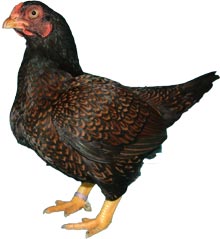
Uses: Utility: Hybrid crosses for table birds.
Origin: Cornwall, England.
Eggs: 60 – 90 tinted.
Weight: Cock: 3.6 Kg, Hen: 2.7 Kg
Bantam Cock: 2.0 Kg, Hen: 2.0 Kg.
Colours: Dark, Jubilee, Double Laced Blue.
Useful to Know: Grass in the diet helps to keep their feet rich yellow-orange. Exercise and diet is important, avoid too much corn / treats to stop excess body fat which reduces fertility and egg production. Despite their name, they are not Game bird in the British Poultry Standards.
Photo: Dark Indian Game. Courtesy of Rupert Stephenson.
Indian Game (called the Cornish in the U.S.) is thought to have first originated from birds bred for cock-fighting descended from the Asiatic fighting cocks. These were thought to have been imported by the Phoenicians to Cornwall, South West England, around 850 BC.
They frequently visited Cornwall to purchase tin, supplied by the mines in the region. During the 18th century, ships that visited for the trade would often carry a supply of birds for food during the voyage and sell surplus birds on arrival.
Old poultry books mention crosses of this bird with Malays, Asils and many other possible breeds that eventually made up the Indian Game of today. However, it is still a matter of debate as there were so many exotic breeds and crosses arriving around this time; there could have been all sorts of breeds or crosses used.
Indian Game were first imported into the U.S. in 1877 and first standardised there in 1893 as ‘Cornish’ since breeders were keen to promote them as table birds, and the Indian Game name was associated with cock-fighting. Smaller build White Cornish were created in the U.S. (unrelated to the original Cornish) and were then standardised in the U.S. in 1898.
Since the mid-1800s, they have not been used for cock-fighting (this was banned in the U.K. in 1849), but Indian Game have been used extensively for creating birds for the table due to their broad-breasted build which provides a bird with a large proportion of breast meat. Most commercial broilers in the U.K. have originally come from Indian Game cocks crossed with Dorking or White Rock hens.
Photos
Books
The following books are available. Links take you to the Amazon or other sellers’ pages for the books.
- Popular Poultry Breeds – D. Scrivener – P.90
- Storey’s Illustrated Guide to Poultry Breeds – C. Ekarius – P.81
- British Poultry Standards – P.134
- American Standard of Perfection – P.98
Breed Clubs
These are the breed clubs for Indian Game chickens:
- UK: The Indian Game Club
- US: International Cornish Breeders Association











